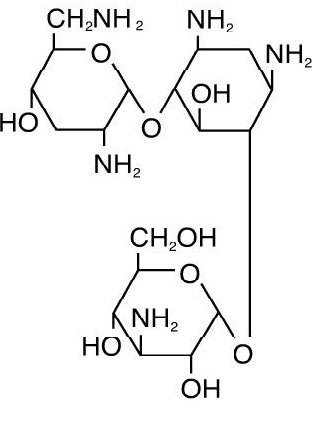DESCRIPTION
Tobramycin ophthalmic solution is a sterile topical ophthalmic antibiotic formulation prepared specifically for topical therapy of external ophthalmic infections.
Each mL of Tobramycin ophthalmic solution USP, 0.3% contains: Active: tobramycin 0.3% (3 mg). Preservative: Benzalkonium chloride 0.01% (0.1 mg). Inactives: boric acid, sodium sulfate, sodium chloride, tyloxapol, sodium hydroxide and/or sulfuric acid (to adjust pH) and water for injection. Tobramycin ophthalmic solution has a pH range between 7.0 and 8.0 and an osmolality of 260-320 mOsm/kg.
Tobramycin is a water-soluble aminoglycoside antibiotic active against a wide variety of gram-negative and gram-positive ophthalmic pathogens.
The chemical structure of tobramycin is:
Molecular Weight = 467.52
Molecular Formula: C18H37N5O9
Chemical name: 0-{3-amino-3-deoxy-α-D-gluco-pyranosyl-(1→4) }-0-{2,6-diamino-2,3,6-trideoxy-α-D-ribohexo-pyranosyl-(1→6) }-2-deoxystreptamine.
CLINICAL PHARMACOLOGY
In Vitro Data: In vitro studies have demonstrated tobramycin is active against susceptible strains of the following microorganisms: Staphylococci, including S. aureus and S. epidermidis (coagulase-positive and coagulase-negative), including penicillin-resistant strains.
Streptococci, including some of the Group A-beta-hemolytic species, some nonhemolytic species, and some Streptococcus pneumoniae.
Pseudomonas aeruginosa, Escherichia coli, Klebsiella pneumoniae, Enterobacter aerogenes, Proteus mirabilis, Morganella morganii, most Proteus vulgaris strains, Haemophilus influenzae and H. aegyptius, Moraxella lacunata, Acinetobacter calcoaceticus and some Neisseria species. Bacterial susceptibility studies demonstrate that in some cases, microorganisms resistant to gentamicin retain susceptibility to tobramycin.
INDICATIONS AND USAGE
Tobramycin ophthalmic solution is a topical antibiotic indicated in the treatment of external infections of the eye and its adnexa caused by susceptible bacteria. Appropriate monitoring of bacterial response to topical antibiotic therapy should accompany the use of Tobramycin Ophthalmic Solution. Clinical studies have shown tobramycin to be safe and effective for use in children.
CONTRAINDICATIONS
Tobramycin ophthalmic solution is contraindicated in patients with known hyper sensitivity to any of its components.
WARNINGS
FOR TOPICAL OPHTHALMIC USE ONLY. NOT FOR INJECTION INTO THE EYE. Sensitivity to topically applied aminoglycosides may occur in some patients. If a sensitivity reaction to Tobramycin ophthalmic solution occurs, discontinue use.
PRECAUTIONS
General
As with other antibiotic preparations, prolonged use may result in overgrowth of nonsusceptible organisms, including fungi. If superinfection occurs, appropriate therapy should be initiated. Cross-sensitivity to other aminoglycoside antibiotics may occur; if hypersensitivity develops with this product, discontinue use and institute appropriate therapy. Patients should be advised not to wear contact lenses if they have signs and symptoms of bacterial ocular infection.
Information For Patients
Do not touch dropper tip to any surface, as this may contaminate the solution.
Pregnancy Category B
Reproduction studies in three types of animals at doses up to thirty-three times the normal human systemic dose have revealed no evidence of impaired fertility or harm to the fetus due to tobramycin. There are, however, no adequate and well-controlled studies in pregnant women. Because animal studies are not always predictive of human response, this drug should be used during pregnancy only if clearly needed.
Nursing Mothers
Because of the potential for adverse reactions in nursing infants from Tobramycin ophthalmic solution, a decision should be made whether to discontinue nursing the infant or discontinue the drug, taking into account the importance of the drug to the mother.
ADVERSE REACTIONS
The most frequent adverse reactions to Tobramycin ophthalmic solution are hypersensitivity and localized ocular toxicity, including lid itching and swelling, and conjunctival erythema. These reactions occur in less than three of 100 patients treated with Tobramycin ophthalmic solution. Similar reactions may occur with the topical use of other aminoglycoside antibiotics. Other adverse reactions have not been reported from Tobramycin ophthalmic solution therapy; however, if topical ocular tobramycin is administered concomitantly with systemic aminoglycoside antibiotics, care should be taken to monitor the total serum concentration.
OVERDOSAGE
Clinically apparent signs and symptoms of an overdose of Tobramycin ophthalmic solution (punctate keratitis, erythema, increased lacrimation, edema and lid itching) may be similar to adverse reaction effects seen in some patients.
DOSAGE AND ADMINISTRATION
In mild to moderate disease, instill one or two drops into the affected eye(s) every four hours. In severe infections, instill two drops into the eye(s) hourly until improvement, following which treatment should be reduced prior to discontinuation.
HOW SUPPLIED
5 mL sterile solution is packaged in a 10 mL white LDPE bottle and natural LDPE nozzle and White HDPE cap (NDC 71205-101-05) containing Tobramycin ophthalmic solution.
TAMPER EVIDENT SEAL
Storage: Store at 2° - 25°C (36° - 77°F).
For Product Inquiry call +1-800-417-9175
Revised: October, 2019
Manufactured for:
Somerset Therapeutics, LLC
Hollywood, FL 33024
Made in India
Code No.: KR/DRUGS/KTK/28/289/97
ST-TBR11/P/01
Relabeled By:
Proficient Rx LP
Thousand Oaks, CA 91320

